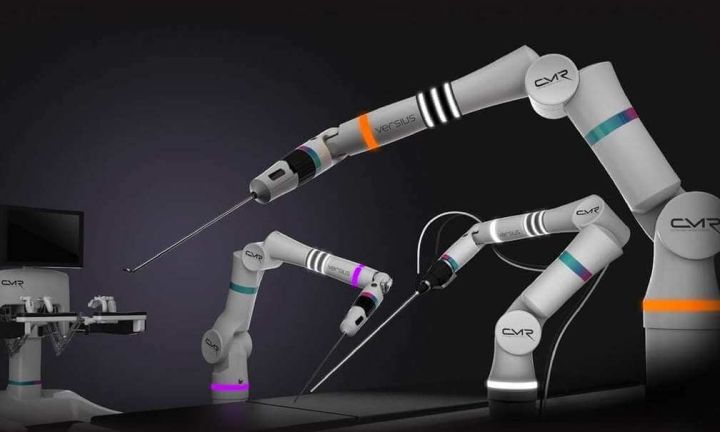In a rural area of Britain, a team of 100 scientists and engineers first used low-cost technologies to develop mobile phones and the aviation industry. Later, these technologies were used to research robot arms, which can be specially used for minimally invasive surgery.
British scientists have developed the world's smallest surgical robot, which can change the operation mode and operate thousands of patients every day.
The robot, called "Versius", mimics the human arm in shape and can be widely used in laparoscopic surgery, including hernia repair, colorectal surgery, prostate and ear surgery, nose and throat surgery. In these operations, some small local incisions are needed to avoid the need for traditional open surgery. This can prevent complications, relieve patients' pain and make them recover quickly.
Guided by the 3D screen in the operating room, the robot is controlled by a surgeon.
The Cambridge medical robot manufacturer said that the surgical robot has been invented and is more convenient to use. It is only one third the size of existing machines, and its surgical price is much lower than that of non intelligent minimally invasive surgery.
Martin Frost, CEO of the company, said: "The idea of using robots to perform surgery is not uncommon." At present, the thorny problem is that it is expensive. Not only is their quotation about 2 million pounds each, but also they need to spend an additional 3000 pounds each time they are put into use. Many hospitals have had to give up using robots for surgery. It is also difficult for the surgical team to control the specifications of the robot.
"They are not fully utilized. They are only used for pelvic surgery, and other types of surgery are difficult to adapt to. In some hospitals, they are only used once every other day."

Frost said: "If you want robots to bring about disruptive changes in surgery, they need to understand by analogy, which is not only convenient and fast, but also small and exquisite. Only in this way can surgeons move them at will in the operating room and put them away after surgery. The robot we invented meets all these requirements. It is the first robot specially developed for laparoscopic surgery."
"One of the advantages of this robot is that its working principle is similar to the human arm. When performing surgery in the patient's body, it can use corresponding science and technology to detect resistance to ensure that the surgery is in place."
"When we want to use science to solve problems, we tend to return to nature," said Luke Hares, chief technology officer of Cambridge Medical Robotics. "We got inspiration from the human arm, which is the greatest surgical tool ever."
Hares said that the researchers observed how the human arm, especially the joints on the wrist, moved, and drew a sketch of how these joints led the arm to move accurately and flexibly. Then the researchers applied these actions to the robot "Versius".
The traditional robot arm is clumsy and unskillful. Each wrist has only three joints. The robot arm we developed is the same size as the human arm. Each wrist has four joints, which allows surgeons to experience unprecedented freedom when performing surgery. This allows doctors to operate on patients from multiple angles and functions.
In order to create this high-end and sophisticated robot, the inventor of Versius used the electronic devices of mobile phones to help the robot "think" and process information. At first, the transmission technology was designed for the aerospace industry, but now it is used to help the robot move.
"Another advantage is that robots don't feel tired," Hares said.
The robot will be put into use next spring. As long as the surgeon knows how to control the robot, it can operate on patients by the end of next year.
The Cambridge medical robot team said that it had cooperated with the British National Medical Service and private hospitals to introduce these robots. At present, the global market value of surgical robots is about US $4 billion per year, but it is estimated that this number will increase to US $20 billion by 2024.
